Rolex Cosmograph Daytona Vs. Zenith Chronomaster Sport: Head To Head
by Tim Mosso
Day one for the Zenith Chronomaster Sport was January 21, 2021. And it seemed like everyone had the same reaction: “That is one aggressive Rolex tribute.” To be fair, the Chronomaster Sport is far more than that, but the initial head-on press photos raised both eyebrows and the temperature on social media. Given zero wrist time and limited images, social media figures did what they do and made themselves the story in a fit of splenetic rants.
Forget all that. The Chronomaster Sport is a distinctive product with its own identity and soul. But let’s see how it stacks up against the mighty Rolex Cosmograph Daytona anyway.
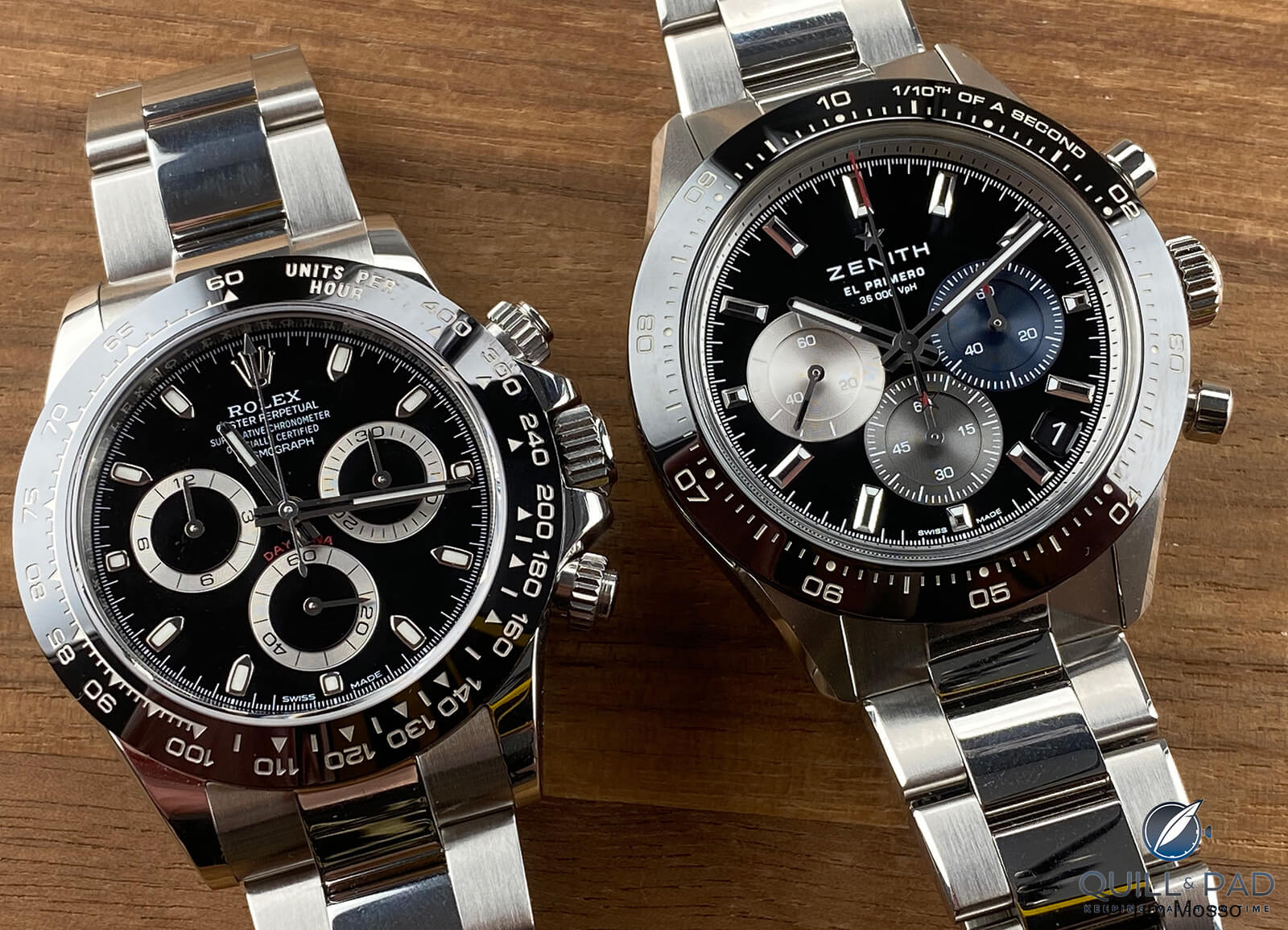
Rolex Cosmograph Daytona (left) and Zenith Chronomaster Sport
Zenith Caliber 3600 vs. Rolex Caliber 4130
Start with the best part of every Zenith: the inside. Caliber 3600 arrived in 2019 for the El Primero’s fiftieth anniversary, and it was the long-awaited “El Primero Mark II” in all but name. It was worth the wait.
Zenith’s reborn chronograph gains ten hours of power reserve – now 60 – and hacking seconds, but the real strength of this movement is that it looks as good as it runs. Zenith stuck with a traditional lateral coupling, and it was the right move. It’s beautiful, entirely visible, and upholds the El Primero’s reputation as a rare beauty among automatic chronograph calibers.
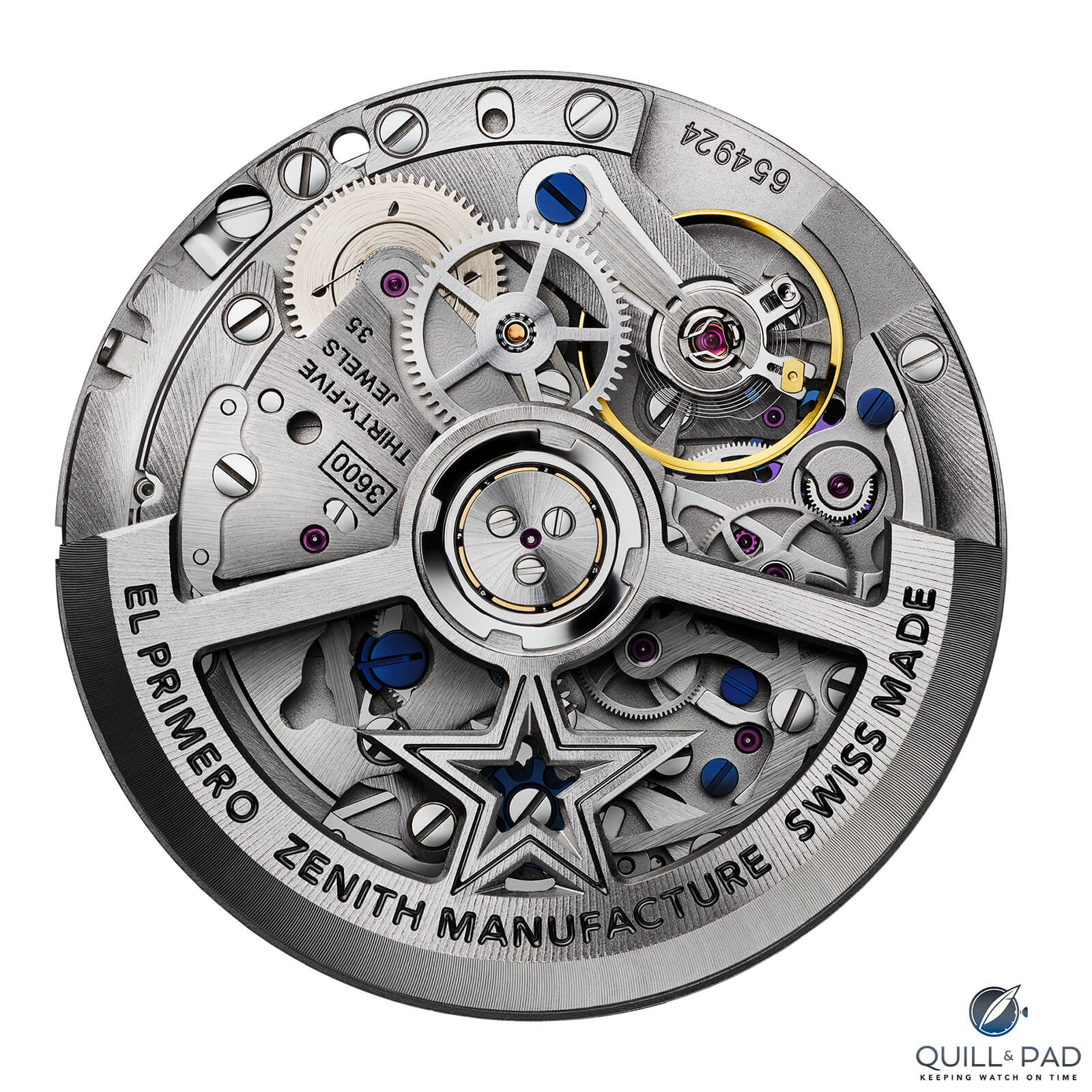
Zenith El Primero Caliber 3600
Unlike most automatic chronographs, Caliber 3600 buries neither its clutch nor its column wheel under the winding system; hammers and levers are visible.
Rolex’s Caliber 4130, like most modern automatic chronograph movements, is all bridges and rotor. The vertical clutch isn’t particularly photogenic so it’s no loss that it hides beneath a solid case back.
It’s worth elaborating on this point: Zenith clearly thought about how this movement would strike the eye. Spiral-spoke clutch wheels are a nod to antiquity even as the nickel-anthracite coating of the bridges takes a hyper-modern turn. Zenith uses both blued and polished screws – they indicate different purposes to the watchmaker – and the violet gleam of the pivot jewels pops against the dark base. The balance explodes in a luminescent gold hue.
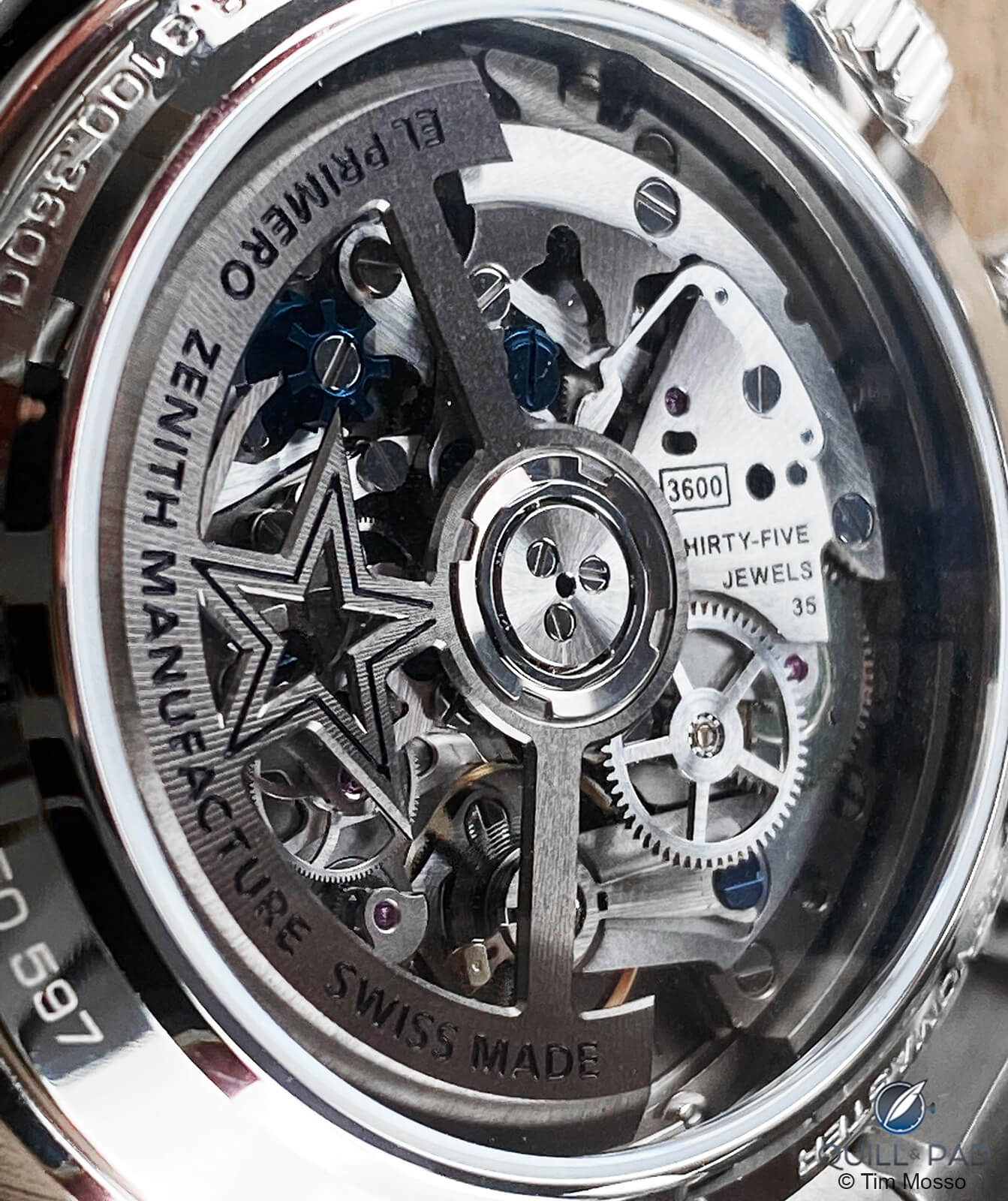
View through the display back of the Zenith Chronomaster Sport
This is a movement made to be seen.
Zenith Chronomaster Sport vs. Rolex Cosmograph Daytona: functionality and design
More of Zenith’s Le Locle magic emerges in the contours of the Chronomaster’s case, which eschews the tapered grace of the Cosmograph for a more robust and complex form that’s recognizable as a Zenith.
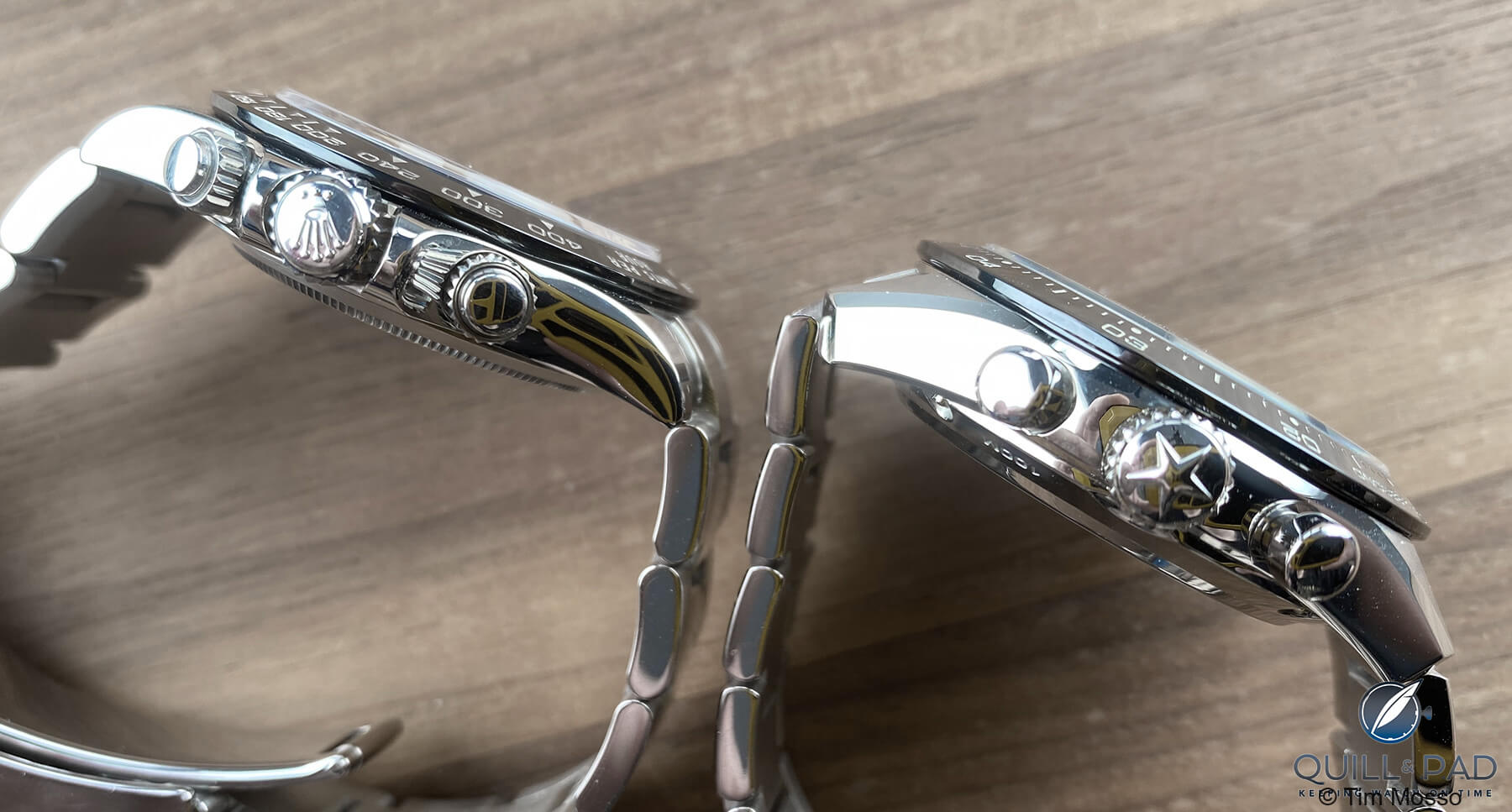
Tapered lugs of the Rolex Cosmograph Daytona (left) and square lugs of the Zenith Chronomaster Sport
The squared-off lug tips, a full-length bevel, pump pushers, and satin-finished lug hoods are purebred Chronomaster flourishes established long ago. For good measure, a tiny kerf below the crown enables easy manipulation with a fingertip.
Frankly, the Zenith also is a bit of a chunk. Its 13.8 mm thickness is a full 1.5 mm beyond the svelte Rolex Daytona, and it’s obvious in person. But that’s the price to be paid for gorgeous movement architecture and a sapphire crystal case back.
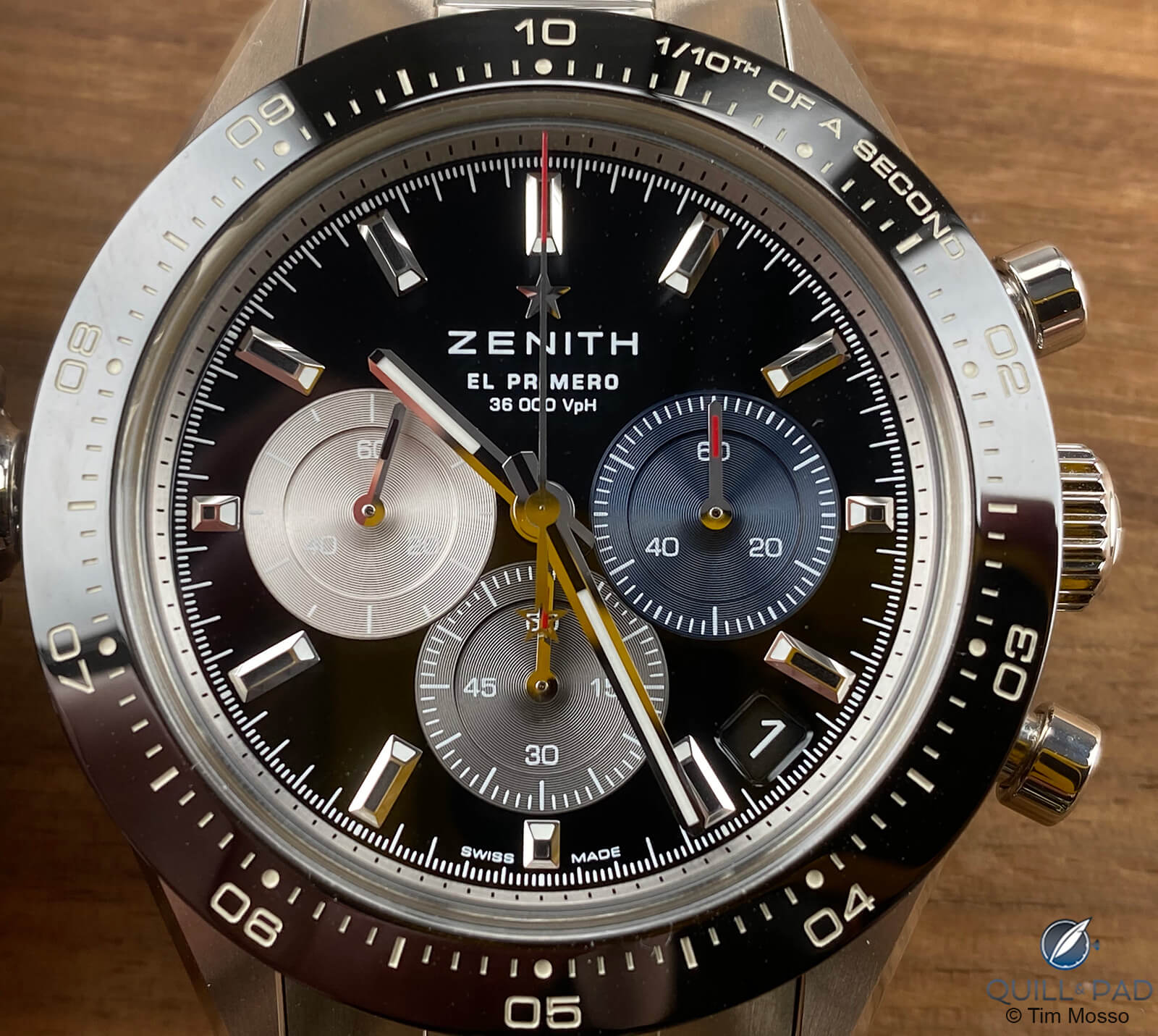
Zenith Chronomaster Sport dial
But that dial! That bezel! Geneva! True, 22 years after the last El Primero-powered Daytona, Zenith felt the impulse to revisit its famous ex. And, yes, when reduced to Atari levels of resolution, photos of the two are uncanny. Look deeper.
Zenith’s Striking Tenth foudroyant chronograph bowed a decade ago, but it still electrifies. Unlike the Daytona’s tachymeter, Zenith’s ceramic bezel is a ten-second scale designed to make the previously academic El Primero five-Hertz escapement a usable feature. Along the rim of the dial, each full second of chronograph operation is spaced over 36 degrees; this makes the recorded tenths large enough to see without eagle eyes or a loupe. And, yeah, it looks like a riot in operation.
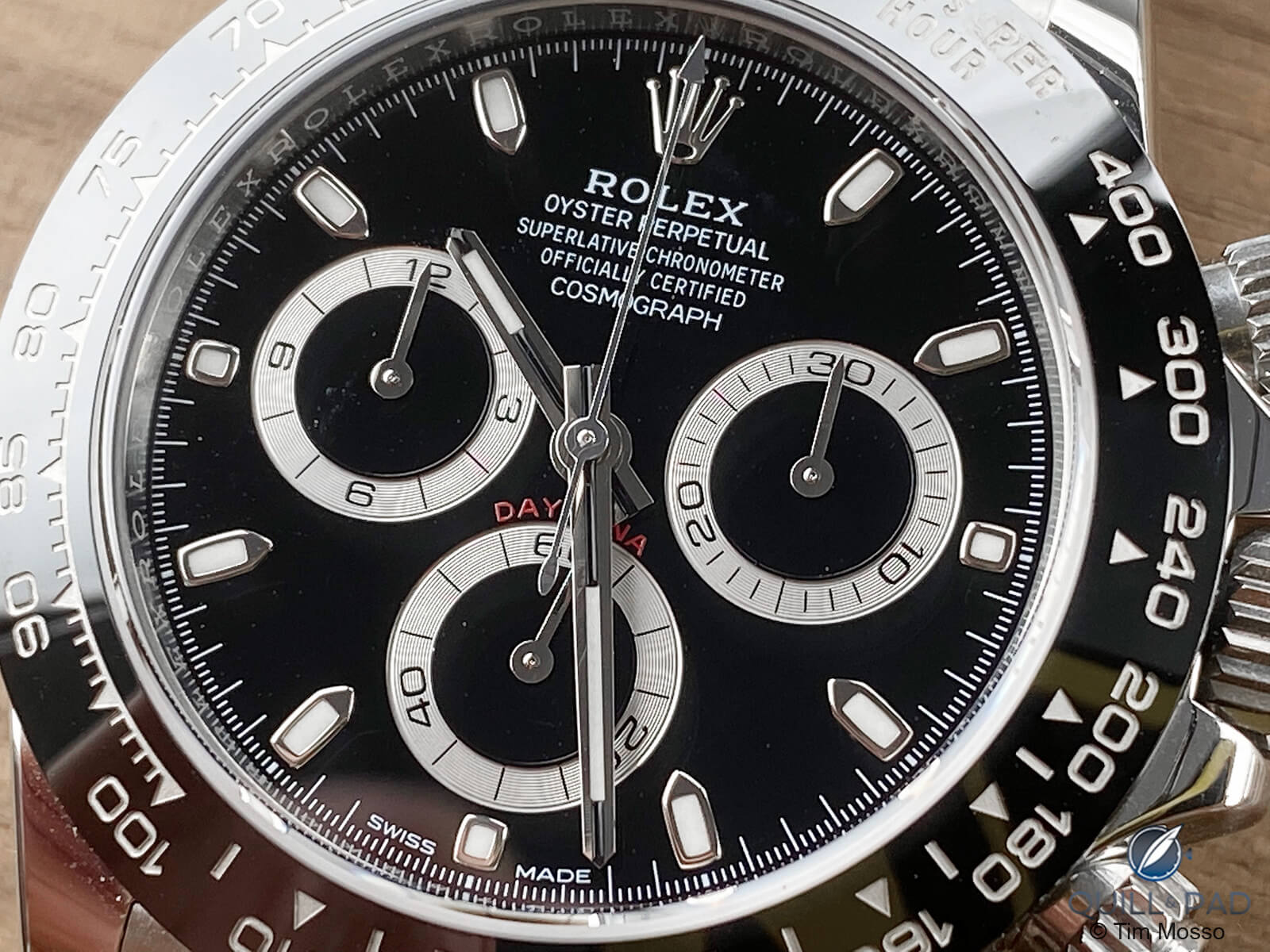
Rolex Cosmograph Daytona dial
The Rolex? It starts, stops, and resets. Done.
Zenith offers both white and black dial options – which does nothing to discourage the Rolex comparisons. The colors take clear cues from The Crown in Geneva, but the details are all Le Locle. A 4:30 date indicator hews closely to El Primero history, and the overlapping tri-tone registers at center are straight off the Zenith A386 of 1969. Hands and indices are unique to the model and reflect a clear break with anything happening on Rue François-Dussaud.
The Chronomaster Sport’s factory strap offering puts more daylight between it and the Daytona. While aftermarket firms are happy to assist, Rolex never intended for the 116500LN generation of the Cosmograph Daytona to include a strap, and swapping to a non-OEM solution often looks awkward. The Zenith, by comparison, looks just as sharp in either configuration.
As strong as the Chronomaster Sport is, the weak link lies among the links of the bracelet. Zenith’s design trades heavily on Oyster precedent, but the result falls short. Although the three-link Chronomaster Sport bracelet is solid enough and all links are removable, the counter-torqued links include screw heads on both sides. That means owners will require a specialized jig or Philippe Dufour-level dexterity with twin flatheads to size their bracelets without leaving scars.
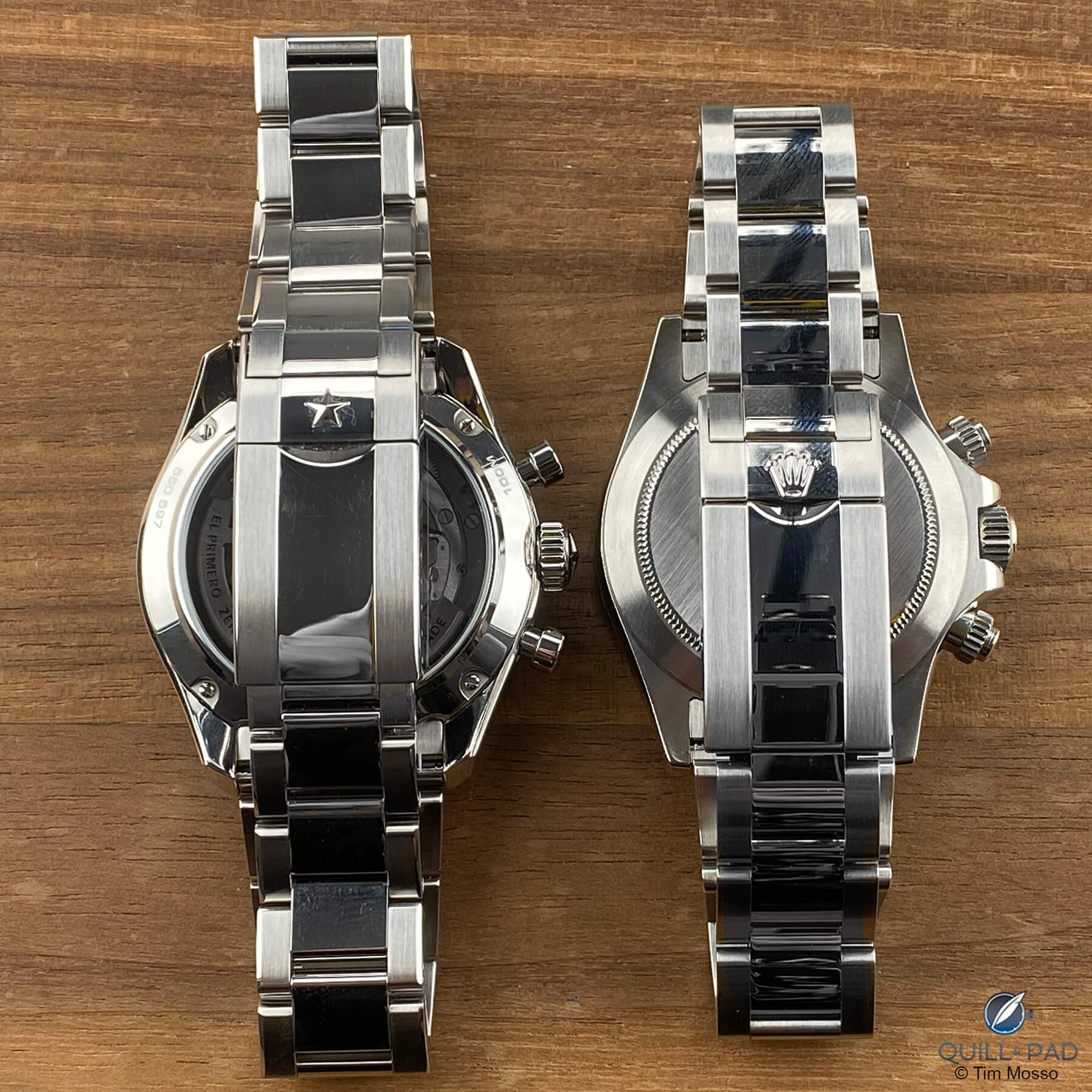
Bracelets and deployant clasps of the Zenith Chronomaster Sport (left) and Rolex Cosmograph Daytona
The deployant clasp is the low point of this Zenith. Not only is this the design element most directly drawn from Rolex, but the quality feels out of step with the remainder of the Chronomaster. Ironically, the Zenith clasp feels like a throwback to the Oyster clasps of the 1990s – the era of the Zenith-powered Daytona. Constructed of thin gauge-stamped steel and externally perforated for sizing adjustments, this clasp looks and feels like a relic of the last century or something suitable for a sub-$2K sports watch in 2021.
On the wrist, it’s easy to forget about the clasp, and the fidgety bracelet need be sized only once. There’s a reassuring solidity to the Chronomaster Sport, which benefits from its relatively chunky proportions and considerable weight. Many watch collectors associate this subjectively beefy feel with luxury, and the Sport’s wrist feel is more tangible than the lighter Daytona.
Compliments from watch folks come fast and furious, and the Chronomaster Sport’s controversial origins make it a rare attention magnet from low-profile Zenith. Everyone wants to see it, try it, and judge it for themselves. All due regard to the danger of small sample sizes, but most collectors who encountered the Chronomaster Sport came away impressed and convinced that the watch is more of a Daytona rival than a Daytona knockoff. This Zenith charms on merit.
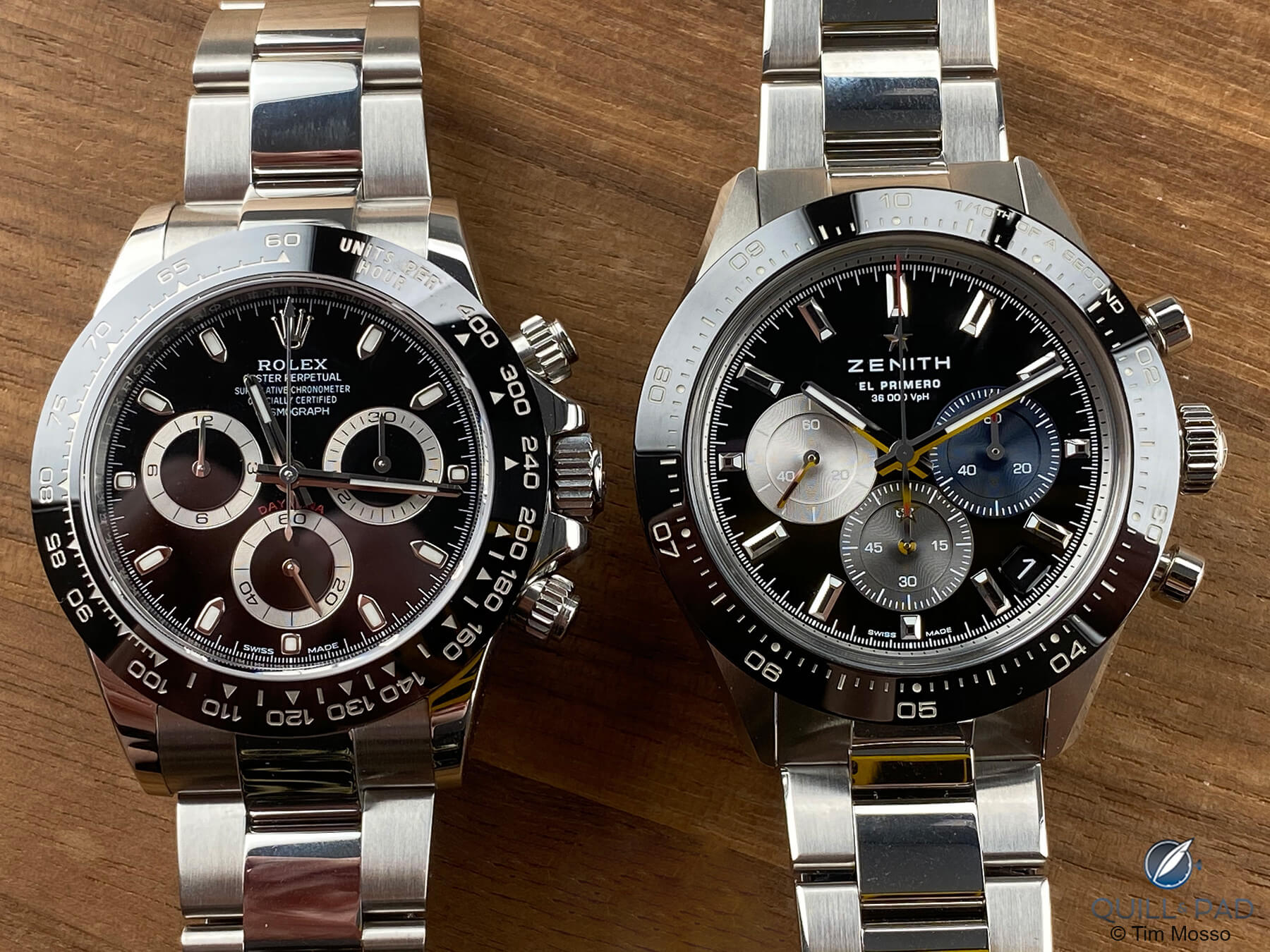
Rolex Cosmograph Daytona (left) and Zenith Chronomaster Sport
A larger watch brand or a more direct market rival to Rolex probably wouldn’t have risked a watch like the Chronomaster Sport. But Zenith isn’t Omega, and the Chronomaster Sport won’t cost Rolex a single Daytona sale. Instead, we have a watch-nerd brand looking to find a fashion footing in a world where its celebrated movements often struggle for aesthetic identity.
The bottom line: price
Pricing also matters. As of October 2021, the steel Rolex Daytona retails for $13,150, and the Zenith Chronomaster Sport retails for $9,500 on a strap or $10,000 on a bracelet. Reality bites in the form of years-long dealer waiting lists for the Rolex and markups approaching $40,000 to buy the watch immediately preowned. The Zenith, by comparison, is available both new and used for approximately its retail price. And, no, the Rolex isn’t four times better than the Zenith.
From its January launch, the Chronomaster Sport’s appearance has drawn immediate comparisons to the Rolex Daytona. With the benefit of wrist time, head-to-head comparison, and reflection, a more balanced view of the Zenith puts the contentious watch in perspective. The Chronomaster Sport is Swiss engineering’s equivalent of present-day Lynyrd Skynyrd: neither a cover act nor all original blood, but still a blast.
For more information, please visit www.zenith-watches.com/int/chronomaster-sport
Quick Facts Zenith Chronomaster Sport 03.3100.3600/21.M3100
Case: 41 x 13.8 mm, stainless steel, 100-meter water resistance with push-down crown
Movement: automatic El Primero Caliber 3600 with lateral clutch column wheel chronograph, 60-hour power reserve, 36,000 vph/5 Hz frequency, silicon escapement, flat hairspring, 10-second foudroyant
Functions: hours, minutes, hacking seconds; date, foudroyant chronograph
Retail price: $10,000
Quick Facts Rolex Oyster Perpetual Cosmograph Daytona 116500LN-0001
Case: 40 x 12.3 mm, stainless steel, 100-meter water resistance with screw-down crown
Movement: automatic Caliber 4130 with column wheel and vertical clutch chronograph, 72-hour power resreve, C.O.S.C. official Swiss chronometer certification, 28,800 vph/4 Hz frequency, full balance bridge and free-sprung balance, overcoil hairspring,
Functions: hours, minutes, hacking seconds; chronograph
Retail price: $13,150
Tim Mosso is the media director and a watch specialist at Watchbox.
This post was first published on November 28, 2021 at Rolex Cosmograph Daytona Vs. Zenith Chronomaster Sport: Head To Head.
You may also enjoy:
Zenith Chronomaster Sport: A Chronograph That Reinvigorates The Senses



Leave a Reply
Want to join the discussion?Feel free to contribute!